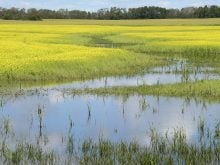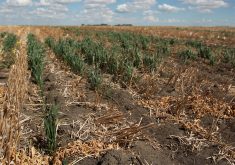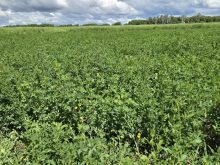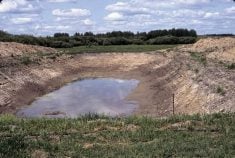Improving the Prairie: Research helps Man. potato farm compare conventional and organic effects on soil and water
Editor’s note: This story is part of an ongoing series that looks at how many farmers are attempting to preserve their soil while increasing profits.
Farmers are always running real-world experiments.
In crop production systems where a complex rotation, customized management, volatile prairie weather and changing technology are constantly challenging farmers, nobody is short on real-world results to ponder.
But Gord Penner is hoping for beefed-up information on his company’s potato fields to help it further boost production, stability and long-term viability simultaneously. If the farm’s production can’t be improved at the same time as it protects its soil and water resources, it will be harder to build a sustainable future.
Read Also

Frost-free season lengthens this year
Saskatoon, Edmonton, and Dauphin saw their frost-free season range from 131 to 135 days, which is about 15 to 20 days longer than average.
Other stories in this series:
- Improving the Prairie
- For the love of soil
- Farmers often dare to experiment — and sometimes fail
- Farm diversifies while improving environment
- Sustainability called evolution, not quick cure
“I think they go hand-in-hand,” said Penner, the head agronomist for major Manitoba-Saskatchewan potato and onion producer Kroeker Farms, as earth movers grunted behind him, restoring a large water reservoir.
“It’s not an easy thing to shoot for, but it’s worth shooting for and I think we can do it.”
Kroeker grows about 6,000 acres of potatoes per year, making it a major supplier to the food industry. It carries out both conventional and organic production, requiring it to operate different management systems for each stream.
The organic system’s requirements has Kroeker incorporating hemp, onions, green manure and edible beans into some fields’ rotations, which is much different than in the conventional stream. The organic side also uses composted manure as fertilizer.
That’s an opportunity for Penner to compare the differences in impact on soil and water over time. Kroeker is getting help on that from the Living Labs program overseen by Agriculture Canada and provincial organizations in four provinces, including Manitoba.
Living Labs is examining real crop and animal farming operations to see what impact various farming and management practices have upon soil, water and wildlife. Farmers who work with the program can find various monitoring systems installed on their land.
On this operation, which has significant tile drainage, water monitors analyze both tile drain outflows and water coming off the surface. Various soil health measures are also examined, including diseases, microbes and carbon content.
Nutrients that flow off the land are lost resources, so Penner hopes a better understanding of the farm’s operations and their impacts will help it retain more, build up the quality of the soil, and preserve and improve the quality of the water it uses and that leaves its land.
“We were worried we wouldn’t have enough water for the potatoes here,” said Penner.
The giant reservoir behind him is supposed to hold enough water for most of the crop’s irrigation needs, but this spring the runoff in the local stream was so little that it wasn’t filled.
The farm has been trying to work in a more sustainable way for years, with this earthen water storage relying upon excess spring runoff seeming like a better option than pumping water from wells. It has helped solve spring drainage problems while not draining local water supplies.
Fortunately, enough rain fell this summer to get the crop through, but there wasn’t enough to get good outflow measurements from the fields. However, droughts are a prairie reality and Henry Wilson of Agriculture Canada said this year will help researchers assess the reality of years like 2021.
“It gives us something to track through time and understand where to target some the practices,” said Wilson, who is based in Brandon.
“It’s good to have that range. The response can be very different depending on whether it’s a dry year or a wet year.”
The earth movers are rumbling away on the water storage’s slopes. The very dry conditions allow for a lot of maintenance that wouldn’t be possible in a typical Manitoba summer, where saturation is more common than drought.
This weather has been a challenge to all farmers, but like many, Penner is happy to have received enough rain to get by, and he hopes the challenging conditions offer new insights about his farm’s operations.
Next year might be a more normal year, which most farmers would welcome, but this year’s challenges came with a glimmer of light for Penner. If the difficult situations lead to more understanding about how his farm’s cropping systems function in extreme circumstances, he hopes that helps him and other farmers be better prepared next time.


















